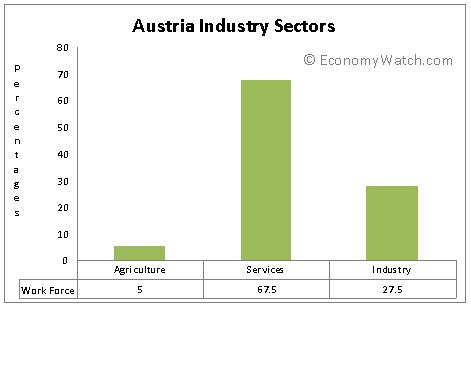Austria Industry Sectors
Please note that we are not authorised to provide any investment advice. The content on this page is for information purposes only.
Austria’s industry sector is diverse, with many traditional forms of industry. Food production, automobiles, parts and textiles are the main pillars of the industry sector. Austria’s industries are strategically placed in proximity to the raw materials needed to run the industries. Textile industries usually restrict themselves to the mountainous west, whereas the machinery segment thrives in the east, beside the glass, chemicals and electrical goods industries. Heavy industry is located in Vienna, Linz, Leobon and other river corridors.[br]
Austria’s industry sector is diverse, with many traditional forms of industry. Food production, automobiles, parts and textiles are the main pillars of the industry sector. Austria’s industries are strategically placed in proximity to the raw materials needed to run the industries. Textile industries usually restrict themselves to the mountainous west, whereas the machinery segment thrives in the east, beside the glass, chemicals and electrical goods industries. Heavy industry is located in Vienna, Linz, Leobon and other river corridors.[br]
Austria Industry Sectors
Although the industry sector contributes 32.3% (2009 est.) of the GDP, in reality, it possesses higher potential. Austria is the world’s largest producer of magnesite and considerable amounts of lignite, wolfram, antimony, graphite, dolomite, salt, quartz, gypsum and kaolin are also found in the nation. Therefore, a slight shift in focus can help the country increase its productivity by a huge margin. The Austrian industry sector employs 27.5% of the total work force. The companies are mostly small and privately owned. The few larger companies are state owned.[br]
This is how the Austrian industry sector shares the work pool within itself:

[br]The various industry segments are:
-
Construction
-
Machinery
-
Vehicles and parts
-
Food
-
Metals
-
Chemicals
-
Lumber and wood processing
-
Paper and paperboard
-
Communications equipment
-
Tourism
-
Production and related manufacturing accounts for a major portion of the GDP, followed by chemical and food stuffs. In a nut shell, Austria’s industry sector has made a major transition from being a ‘rust belt’ industry to a more expansive one. With a little more focus on tapping the natural resources, the country can grow at a higher rate.




